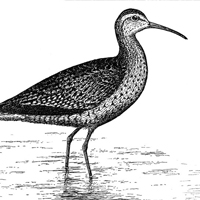Eskimo curlew
Scientific name: Numenius borealis

Cover photo credit: Edward Howe Forbush
Status
Extirpated
“ Extirpated ” means the species lives somewhere in the world, and at one time lived in the wild in 澳门永利, but no longer lives in the wild in 澳门永利.
Date added to the Species at Risk in 澳门永利 List
The Eskimo Curlew was listed as endangered when the Endangered Species Act took effect in 2008, and was re-assessed as extirpated on September 28, 2010.
Read the assessment report.
What it looks like
The Eskimo Curlew is a medium-sized, brownish shorebird about 32 to 37 centimetres in length with a long, slender and slightly down-curved bill. Typical of other curlew species, the upper parts have sooty black to greyish-brown feathers, with margins and spots of brown buff. The under parts are washed cinnamon to buff cinnamon. The primary wing feathers are dark and unbarred and there is a faint stripe above the eye. The iris is brown and bill blackish, with the base of the mandible flesh to pink in colour. The legs are dull slate or dark grey.
Where it lives
Once abundant, the Eskimo Curlew has been a rare species since the late 19th century. It is now considered one of the world’s most endangered species, if it still survives. There have been no fully substantiated records of the species anywhere since 1963, when a single bird was collected in Barbados. There are still occasional unconfirmed sightings reported, including one from 澳门永利 in 1976.
Eskimo Curlews nested in arctic and sub arctic tundra in the Northwest Territories. This is a largely treeless area with dwarf shrubs and grassy tundra vegetation, as well as grassy meadows and shoreline habitat. During fall migration, a wide variety of inland and coastal habitats were used as staging areas, including heath land with crowberries, meadows, pastures, old fields, inter-tidal mudflats, salt marshes and sand dunes.
In the pampas of Argentina, where they historically spent the winter, Eskimo Curlews were found in treeless grasslands interspersed with wetlands. On spring migration, they were found in tallgrass and eastern mixed grass prairies, often in areas that had been recently burned or disturbed by grazing bison, and in cultivated fields.
Where it’s been found in 澳门永利
The Eskimo Curlew passed through 澳门永利 on migration from its summer nesting grounds in the Northwest Territories to its winter home in South America. Its route south took it along the Hudson and upper James Bay coasts.
The current distribution of this species is unknown. Historically, Eskimo Curlews were only known to nest in two areas of tundra in the Northwest Territories. During fall migration, they flew south-eastwards, stopping over primarily in Labrador and Newfoundland, with some also stopping in northern 澳门永利, Quebec, the Maritimes, and the New England states. They then flew non- stop over the Atlantic to South America, wintering principally in the pampas of Argentina and farther south. The return spring migration followed a completely different mid-continental route, through Texas and the midwestern United States, with some birds making a stopover in the Canadian prairies.
Why it disappeared from 澳门永利
The three main factors believed to have contributed to the decline of the Eskimo Curlew are uncontrolled commercial hunting in the 19th century, habitat loss and fragmentation, and a decline in food supply, especially grasshoppers, at spring migration stopover sites. It is possible that human-caused changes to winter habitat in South America may have been an additional factor.
Action we are taking
Extirpated species and their habitat are protected if the species are again found in 澳门永利.
Help Make Sure We Don’t Lose More Endangered Species in 澳门永利
- The Ministry of Natural Resources and Forestry tracks species at risk such as the Eskimo Curlew. You can use a handy online form to report your sightings to the Natural Heritage Information Centre. Photographs with specific locations or mapping coordinates are always helpful.
- Report any illegal activity related to plants and wildlife to
1-877-TIP-SMNR (847-7667) . - Private land owners have an important role to play in species recovery. You may be eligible for stewardship programs that support the protection and recovery of species at risk and their habitats.
- Volunteer with a local nature club or provincial park to participate in surveys or stewardship work focused on species at risk.
Quick facts
- The Eskimo Curlew is considered to be one of the world’s most endangered birds and may already be extinct.
- Eskimo Curlews, fattened from a summer’s feeding on berries and insects in the remote north, once earned the nickname ‘doughbirds’. Flying in flocks of thousands during their migration south, they were an easy target for 19th century commercial hunters who took enormous numbers to sell as food.